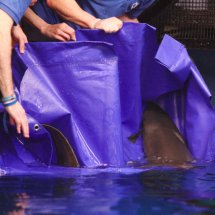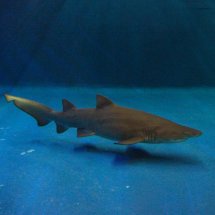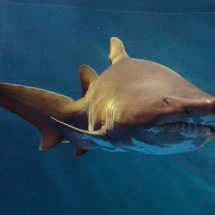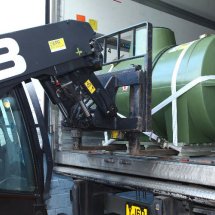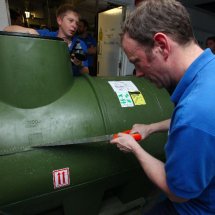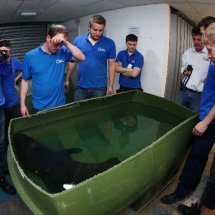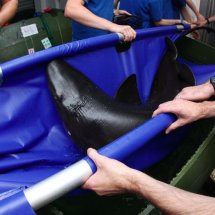NMA SAND TIGER SHARKS ARRIVAL
The National Marine Aquarium has welcomed two very special Sharks to its family, with the arrival of the first captive bred Sand Tiger Sharks in the Northern Hemisphere.
Travelling from South Africa, where they are known as Ragged Toothed Sharks - one female, called uShaka and one male, called Mandela - were born at the uShaka Seaworld, Durban, in March 2013 and December 2014 respectively. With almost two years on her brother, uShaka is the largest of the pair measuring in at 2.0 metres, while Mandela is currently 1.6 metres. As they mature, the Sand Tiger Sharks could grow to be up to 3 metres in length.
Currently in quarantine following their travels from South Africa, the new Sand Tiger Sharks will be released into the Atlantic Ocean Tank in the coming weeks. Where they will have their own private area at the back of the exhibit to allow them to settle before joining fellow Sand Tiger Shark residents, Howard and Enzo, as well as the likes of Eagle Rays, Nurse Sharks, Tarpon, Barracuda and Southern Stingrays.
The Sand Tiger Sharks' arrival not only boosts the Aquarium's Shark population, they also mark a significant feat for the Aquarium - as the first captive bred Sand Tiger Sharks to be shared between Aquariums in the world.
Captive breeding enables Zoos and Aquariums to maintain healthy populations of captive animals and marine life. Keeping data on the captive species enables selective breeding of those with the strongest genes, thus creating the strongest captive population of the species. There are numerous Studbook and Monitoring programmes that exist for terrestrial and marine species in Europe and around the world, to enable better care and breeding programmes.
Since 2013, the National Marine Aquarium has been creating its own monitoring programme for captive Sand Tiger Sharks in Europe - liaising with other Aquariums across to Europe to source and compile the information. The arrival of the new Sand Tiger Sharks is a significant step in the creation and development of the programme, and will enable the Aquarium to actively manage and maintain the current and future captive Sand Tiger Shark population in Europe.
James Wright, Assistant Curator at the National Marine Aquarium, said: “We are delighted to welcome the new Sand Tiger Sharks to the Aquarium. Not only does it bring our number of the largest Shark species at the Aquarium up to four, uShaka and Mandela are also the first captive bred Sand Tiger Sharks to come to the Northern Hemisphere, which is of great significance to our monitoring programme of the species. Their moving is also a world first, as they mark the first time captive bred Sand Tiger Sharks have been shared between Aquariums in the world.
"The monitoring programme will help to ensure the healthiest Sand Tiger Sharks located in Aquariums across Europe are used for future breeding projects. By sharing data, we can be confident Sand Tiger Sharks bred and born in captivity will have the strongest chance of survival and possess the best genes available in the captive Shark pool.
"We hope our visitors look forward to seeing our new Sand Tiger Shark duo at the Aquarium soon."
Travelling from South Africa, where they are known as Ragged Toothed Sharks - one female, called uShaka and one male, called Mandela - were born at the uShaka Seaworld, Durban, in March 2013 and December 2014 respectively. With almost two years on her brother, uShaka is the largest of the pair measuring in at 2.0 metres, while Mandela is currently 1.6 metres. As they mature, the Sand Tiger Sharks could grow to be up to 3 metres in length.
Currently in quarantine following their travels from South Africa, the new Sand Tiger Sharks will be released into the Atlantic Ocean Tank in the coming weeks. Where they will have their own private area at the back of the exhibit to allow them to settle before joining fellow Sand Tiger Shark residents, Howard and Enzo, as well as the likes of Eagle Rays, Nurse Sharks, Tarpon, Barracuda and Southern Stingrays.
The Sand Tiger Sharks' arrival not only boosts the Aquarium's Shark population, they also mark a significant feat for the Aquarium - as the first captive bred Sand Tiger Sharks to be shared between Aquariums in the world.
Captive breeding enables Zoos and Aquariums to maintain healthy populations of captive animals and marine life. Keeping data on the captive species enables selective breeding of those with the strongest genes, thus creating the strongest captive population of the species. There are numerous Studbook and Monitoring programmes that exist for terrestrial and marine species in Europe and around the world, to enable better care and breeding programmes.
Since 2013, the National Marine Aquarium has been creating its own monitoring programme for captive Sand Tiger Sharks in Europe - liaising with other Aquariums across to Europe to source and compile the information. The arrival of the new Sand Tiger Sharks is a significant step in the creation and development of the programme, and will enable the Aquarium to actively manage and maintain the current and future captive Sand Tiger Shark population in Europe.
James Wright, Assistant Curator at the National Marine Aquarium, said: “We are delighted to welcome the new Sand Tiger Sharks to the Aquarium. Not only does it bring our number of the largest Shark species at the Aquarium up to four, uShaka and Mandela are also the first captive bred Sand Tiger Sharks to come to the Northern Hemisphere, which is of great significance to our monitoring programme of the species. Their moving is also a world first, as they mark the first time captive bred Sand Tiger Sharks have been shared between Aquariums in the world.
"The monitoring programme will help to ensure the healthiest Sand Tiger Sharks located in Aquariums across Europe are used for future breeding projects. By sharing data, we can be confident Sand Tiger Sharks bred and born in captivity will have the strongest chance of survival and possess the best genes available in the captive Shark pool.
"We hope our visitors look forward to seeing our new Sand Tiger Shark duo at the Aquarium soon."


